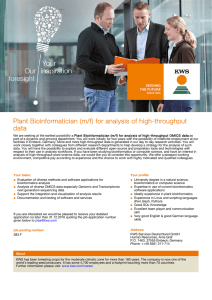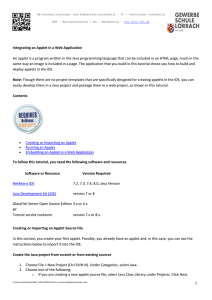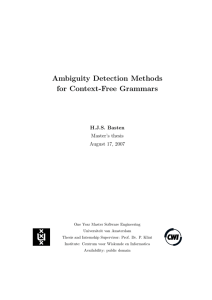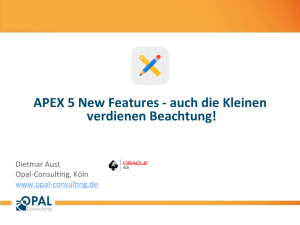Kerstin Eckart Universität Stuttgart, Institut für Maschinelle
Werbung
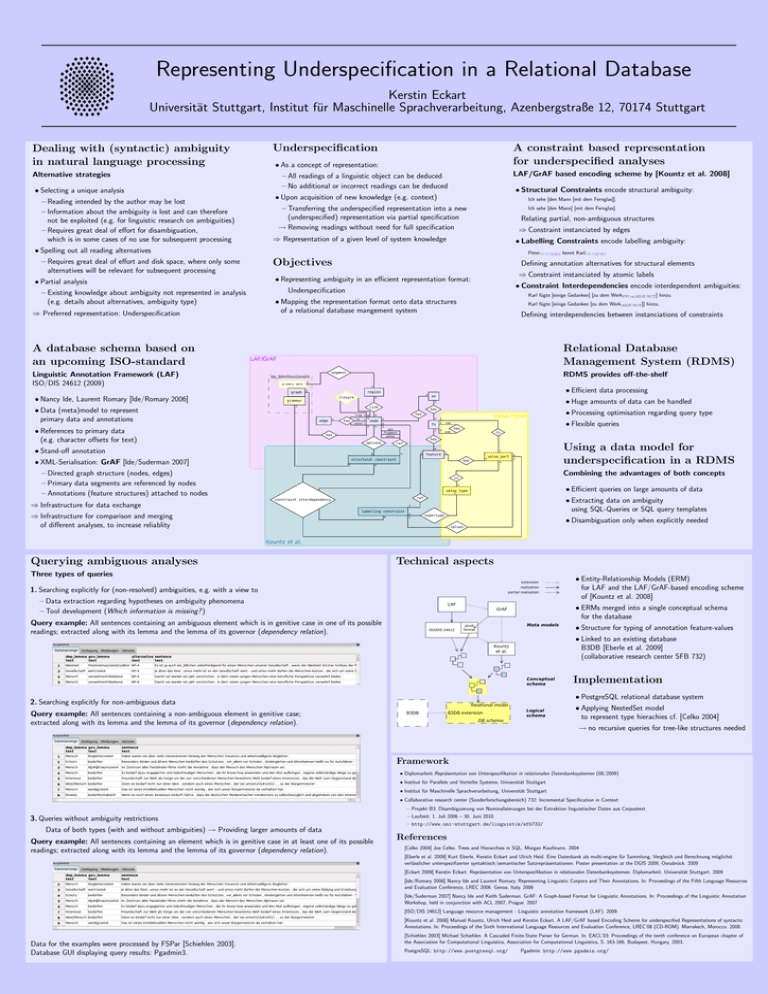
Representing Underspecification in a Relational Database Kerstin Eckart Universität Stuttgart, Institut für Maschinelle Sprachverarbeitung, Azenbergstraße 12, 70174 Stuttgart Underspecification Dealing with (syntactic) ambiguity in natural language processing A constraint based representation for underspecified analyses • As a concept of representation: Alternative strategies LAF/GrAF based encoding scheme by [Kountz et al. 2008] – All readings of a linguistic object can be deduced – No additional or incorrect readings can be deduced • Selecting a unique analysis • Structural Constraints encode structural ambiguity: • Upon acquisition of new knowledge (e.g. context) – Reading intended by the author may be lost – Information about the ambiguity is lost and can therefore not be exploited (e.g. for linguistic research on ambiguities) – Requires great deal of effort for disambiguation, which is in some cases of no use for subsequent processing Ich sehe [den Mann [mit dem Fernglas]]. – Transferring the underspecified representation into a new (underspecified) representation via partial specification → Removing readings without need for full specification Ich sehe [den Mann] [mit dem Fernglas]. Relating partial, non-ambiguous structures ⇒ Constraint instanciated by edges ⇒ Representation of a given level of system knowledge • Labelling Constraints encode labelling ambiguity: • Spelling out all reading alternatives PeterSU BJ |OBJ kennt KarlOBJ |SU BJ Objectives – Requires great deal of effort and disk space, where only some alternatives will be relevant for subsequent processing ⇒ Constraint instanciated by atomic labels • Representing ambiguity in an efficient representation format: • Partial analysis • Constraint Interdependencies encode interdependent ambiguities: Underspecification – Existing knowledge about ambiguity not represented in analysis (e.g. details about alternatives, ambiguity type) Karl fügte [einige Gedanken] [zu dem WerkP P/zu|ADJU N CT ] hinzu. • Mapping the representation format onto data structures of a relational database mangement system ⇒ Preferred representation: Underspecification A database schema based on an upcoming ISO-standard Defining annotation alternatives for structural elements Karl fügte [einige Gedanken [zu dem WerkADJU N CT ]] hinzu. Defining interdependencies between instanciations of constraints Relational Database Management System (RDMS) LAF/GrAF Linguistic Annotation Framework (LAF) ISO/DIS 24612 (2009) segment primary data graph • Nancy Ide, Laurent Romary [Ide/Romary 2006] • Data (meta)model to represent primary data and annotations RDMS provides off-the-shelf obj_definition/content 1 n 1 region closure grammar n n • Efficient data processing as • Huge amounts of data can be handled 1 1 link edge n has from n m to 1 1 annot 1 has m node n • References to primary data (e.g. character offsets for text) has n has 1 n 1 p 1 fs 1 gov fragment annot options 1 n value types • Flexible queries top sub has is has ref n • Stand-off annotation 1 n m feature 1 Using a data model for underspecification in a RDMS 1 1 structural constraint • XML-Serialisation: GrAF [Ide/Suderman 2007] n has value_part q n n n – Directed graph structure (nodes, edges) – Primary data segments are referenced by nodes – Annotations (feature structures) attached to nodes Combining the advantages of both concepts is 1 • Efficient queries on large amounts of data value_type 1 ref constraint interdependency ⇒ Infrastructure for data exchange • Extracting data on ambiguity using SQL-Queries or SQL query templates 1 labelling constraint ⇒ Infrastructure for comparison and merging of different analyses, to increase reliablity m • Processing optimisation regarding query type n 1 supertype • Disambiguation only when explicitly needed values Kountz et al. Querying ambiguous analyses Technical aspects Three types of queries extension realization 1. Searching explicitly for (non-resolved) ambiguities, e.g. with a view to partial realization – Data extraction regarding hypotheses on ambiguity phenomena – Tool development (Which information is missing? ) LAF • ERMs merged into a single conceptual schema for the database GrAF Query example: All sentences containing an ambiguous element which is in genitive case in one of its possible readings; extracted along with its lemma and the lemma of its governor (dependency relation). ISO/DIS 24612 Meta models pivot format • Structure for typing of annotation feature-values • Linked to an existing database B3DB [Eberle et al. 2009] (collaborative research center SFB 732) Kountz et al. Conceptual schema Implementation • PostgreSQL relational database system 2. Searching explicitly for non-ambiguous data Query example: All sentences containing a non-ambiguous element in genitive case; extracted along with its lemma and the lemma of its governor (dependency relation). • Entity-Relationship Models (ERM) for LAF and the LAF/GrAF-based encoding scheme of [Kountz et al. 2008] Relational model B3DB B3DB extension Logical schema DB schema • Applying NestedSet model to represent type hierachies cf. [Celko 2004] → no recursive queries for tree-like structures needed Framework • Diplomarbeit Repräsentation von Unterspezifikation in relationalen Datenbanksystemen (08/2009) • Institut für Parallele und Verteilte Systeme, Universität Stuttgart • Institut für Maschinelle Sprachverarbeitung, Universität Stuttgart • Collaborative research center (Sonderforschungsbereich) 732: Incremental Specification in Context – Projekt B3: Disambiguierung von Nominalisierungen bei der Extraktion linguistischer Daten aus Corpustext 3. Queries without ambiguity restrictions Data of both types (with and without ambiguities) → Providing larger amounts of data Query example: All sentences containing an element which is in genitive case in at least one of its possible readings; extracted along with its lemma and the lemma of its governor (dependency relation). – Laufzeit: 1. Juli 2006 – 30. Juni 2010 – http://www.uni-stuttgart.de/linguistik/sfb732/ References [Celko 2004] Joe Celko. Trees and Hierarchies in SQL. Morgan Kaufmann. 2004 [Eberle et al. 2009] Kurt Eberle, Kerstin Eckart and Ulrich Heid. Eine Datenbank als multi-engine für Sammlung, Vergleich und Berechnung möglichst verlässlicher unterspezifizerter syntaktisch/semantischer Satzrepräsentationen. Poster presentation at the DGfS 2009, Osnabrück. 2009 [Eckart 2009] Kerstin Eckart. Repräsentation von Unterspezifikation in relationalen Datenbanksystemen. Diplomarbeit. Universität Stuttgart. 2009 [Ide/Romary 2006] Nancy Ide and Laurent Romary. Representing Linguistic Corpora and Their Annotations. In: Proceedings of the Fifth Language Resources and Evaluation Conference, LREC 2006. Genoa, Italy. 2006 [Ide/Suderman 2007] Nancy Ide and Keith Suderman. GrAF: A Graph-based Format for Linguistic Annotations. In: Proceedings of the Linguistic Annotation Workshop, held in conjunction with ACL 2007, Prague. 2007 [ISO/DIS 24612] Language resource management - Linguistic annotation framework (LAF). 2009. [Kountz et al. 2008] Manuel Kountz, Ulrich Heid and Kerstin Eckart. A LAF/GrAF based Encoding Scheme for underspecified Representations of syntactic Annotations. In: Proceedings of the Sixth International Language Resources and Evaluation Conference, LREC’08 (CD-ROM). Marrakech, Morocco. 2008. Data for the examples were processed by FSPar [Schiehlen 2003]. Database GUI displaying query results: Pgadmin3. [Schiehlen 2003] Michael Schiehlen. A Cascaded Finite-State Parser for German. In: EACL’03: Proceedings of the tenth conference on European chapter of the Association for Computational Linguistics, Association for Computational Linguistics, S. 163-166. Budapest, Hungary. 2003. PostgreSQL: http://www.postgresql.org/ Pgadmin: http://www.pgadmin.org/

